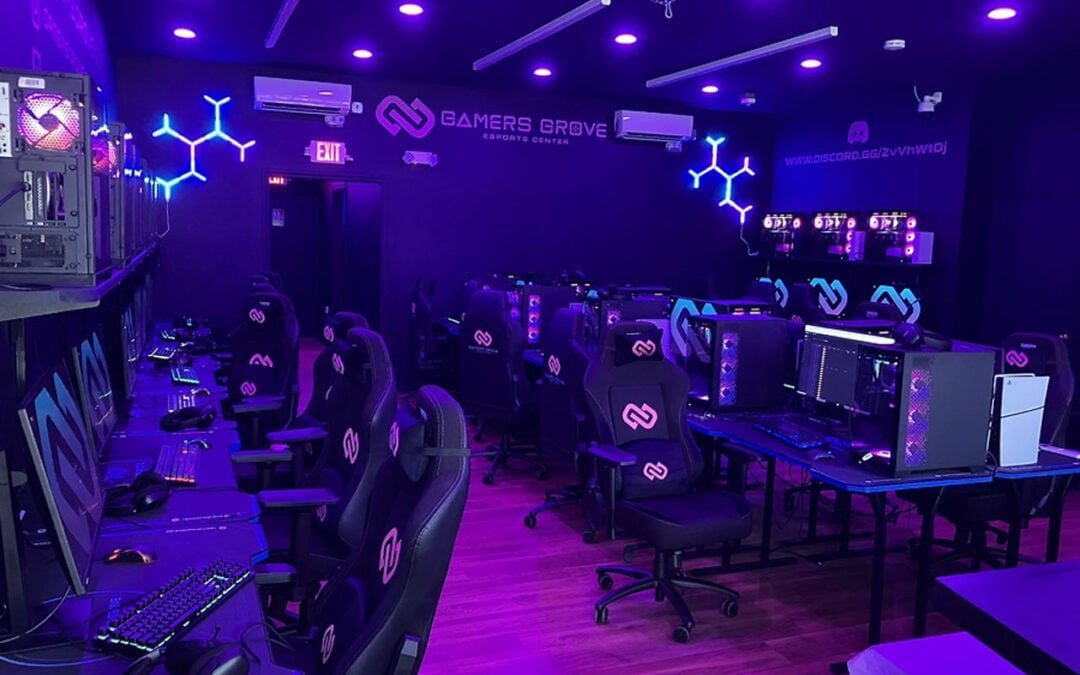The United States esports market is not just growing; it’s surging, presenting a golden opportunity for entrepreneurs looking to tap into a dynamic and expanding industry. This article is designed to illuminate the significant potential and compelling viability of establishing a thriving esports center in the USA in 2025, taking into account the current favorable market dynamics and promising future projections. Let’s delve into it! Note: for the purposes of this article, we are using our own industry data across our network of businesses, as well as trusted data that can be found here and here and here, among others.
Our analysis reveals a market ripe with potential, boasting significant projected revenue growth and a burgeoning audience eager for immersive esports experiences. The key to unlocking this potential lies in strategically leveraging diverse income streams, including memberships, exhilarating tournaments, engaging watch parties, and revenue-generating concessions, alongside innovative educational programs and other revenue opportunities. While initial costs demand careful attention (less so for ongoing expenses), we feel that selecting the right location, investing in cutting-edge technology, nurturing a thriving community are cornerstones of success. By proactively addressing potential challenges, such as competition from home gaming, and staying ahead of technological curves, we believe that a well-crafted business plan and adaptable strategies will pave the way for a prosperous venture. The evidence strongly suggests that establishing an esports center in the USA in 2025 is a promising endeavor for those ready to embrace the excitement and potential of this electrifying industry.
Capitalizing on the Esports Phenomenon with Physical Venues
Esports has exploded from a niche pastime into a global entertainment powerhouse. This thrilling world of organized, competitive video gaming, as described in various articles on this blog, attracts ever-increasing viewership, boasts impressive prize pools, and continues to professionalize at a rapid pace. This expansion isn’t limited to the digital realm; a significant demand is emerging for physical venues where enthusiasts can connect, compete, and fully immerse themselves in the esports experience within a vibrant community setting.
The United States is a dominant force in the global esports market, demonstrating substantial growth in both revenue generation and the cultivation of top-tier talent. In 2024, the US esports market reached a substantial valuation of USD 489 million, with projections indicating a remarkable climb to USD 1,125 million by 2033, representing a robust compound annual growth rate (CAGR) of 9.7% from 2025 to 2033. Another report estimated the US market size at an impressive USD 871 million in 2023. Furthermore, the United States proudly secured the second position worldwide in esports tournament winnings in 2023, amassing a total of $28.7 million. While different reports may present varying market size estimations due to the dynamic nature of the industry and differing definitions of the esports market (potentially including broader categories like betting or content creation), it is undeniable that the consistent upward trajectory clearly signals a strong and expanding market ripe with opportunity.
Despite the inherently digital nature of esports, a tangible and growing need exists for dedicated physical spaces that cater to gaming and esports engagement. Many esports enthusiasts are also passionate gamers seeking dedicated environments to refine their skills or play with friends, whether casual or competitive. Esports centers perfectly address these demand by providing access to high-end gaming equipment and a competitive atmosphere that is extremely difficult to replicate in home setups. Moreover, these venues serve as vital social hubs, fostering a strong sense of community among gamers and offering platforms for organized team practices, exciting local tournaments, and various engaging community-focused events.
The United States Esports Market in 2025: A Landscape of Expansion and Innovation
The US esports market is not just stable; it’s on an upward trajectory, poised for significant expansion in 2025 and beyond. Globally, the esports market is expected to surge from USD 2.06 billion in 2024 to a staggering USD 9.29 billion by 2032, with North America maintaining a significant share (29.06% in 2023). Based on these global figures and North America’s substantial share, the US market size in 2025 could be estimated at approximately USD 0.58 – 0.6 billion (depending on market fluctuations). The consistent and positive growth projections from multiple reputable sources underscore the robust and expanding potential for businesses operating within the US esports ecosystem.
Several powerful factors are fueling this remarkable expansion. The increasing popularity and widespread viewership of esports are primary drivers. Notably, a significant 32% of internet users aged 16-24 and 30% of those aged 25-34 actively tune in to watch esports tournaments. This growing and engaged audience attracts substantial investments and valuable sponsorships from a diverse range of stakeholders. Recent noteworthy examples include the acquisition of Guild Esports by DCB Sports and the strategic partnership between NRG and Spectrum, highlighting the significant financial interest and confidence in the esports sector. Technological advancements also play a crucial role in continually enhancing the gaming experience and making esports more accessible to a wider audience. The innovative integration of artificial intelligence for advanced analytics and the exciting emergence of virtual reality esports are notable developments shaping the future of the industry. Furthermore, the increasing availability of faster internet speeds, significantly boosted by the rollout of advanced fiber networks (and even wireless, to some extent), contributes to a smoother, more reliable, and ultimately more engaging online gaming environment. The ease of access to captivating esports content through popular online streaming platforms like Twitch and YouTube Gaming is another significant factor driving market growth. In 2024, streaming platforms dominated the esports content creation market with an impressive 52.6% share, illustrating their critical importance in reaching a vast and diverse audience. The ever-increasing number of prestigious esports tournaments and events, including high-profile international competitions boasting substantial prize pools, further solidify the legitimacy and widespread appeal of competitive gaming. The rapid rise of mobile esports, facilitated by the widespread availability of powerful smartphones, is attracting an even broader and more diverse audience to the dynamic esports landscape. (Note: while mobile gaming doesn’t directly help an esports center, it just further solidifies the power of gaming across all platforms and devices, and inevitably leads to people looking for more immersive experiences than just their mobile devices. This is where we come in as venue operators).
The US esports market presents various avenues for segmentation. Revenue generation occurs through a multitude of successful models, including valuable media rights, lucrative advertising and sponsorships, engaging merchandise and ticket sales, and other innovative avenues. In 2021, sponsorships emerged as the leading revenue segment in the global esports market, generating an estimated $641 million. Projections indicate that sponsorships and advertising will continue their strong growth, reaching an impressive $1.2 billion by 2028. The platforms on which esports are enjoyed include PC-based, consoles-based, and the rapidly expanding mobile and tablets. The mobile gaming esports scene is experiencing particularly rapid growth, effectively democratizing access to esports for a wider demographic. Popular and engaging game titles within the esports scene span exciting genres like Multiplayer Online Battle Arena (MOBA) such as the globally renowned League of Legends and Dota 2, intense Player vs Players (PvP) games, thrilling First Person Shooters (FPS) like Counter-Strike and Valorant, and strategic Real Time Strategy (RTS) games. Other prominent titles include the widely popular Fortnite and PUBG Mobile, which are leaders in esports prize money. Geographically, the US market can be effectively divided into key regions like the Northeast, Midwest, South, and West.
Several exciting emerging trends are poised to shape the esports landscape in 2025 and beyond. Mobile gaming is expected to continue its remarkable ascent, further democratizing access to the thrilling world of esports. The industry is also witnessing an increasing number of strategic mergers, acquisitions, and consolidations, potentially fostering greater stability, innovation, and growth. The growing prominence of college esports, with universities making significant investments in dedicated programs and infrastructure, signifies a maturing ecosystem and a vital pipeline for future talent. Artificial intelligence is being increasingly utilized in sophisticated esports analytics, with the exciting potential to significantly enhance the spectator experience and provide valuable insights. Financial stability remains a key focus within the esports ecosystem, prompting important discussions around stronger collaboration and mutually beneficial revenue-sharing models among publishers, teams, and tournament organizers. Esports audiences are also expanding into regions beyond traditional strongholds, indicating a significant globalizing phenomenon. A growing emphasis on sustainability and the development of a robust long-term esports ecosystem suggests a maturing industry focused on longevity and responsible growth. Finally, technological advancements in online gaming, including the innovative integration of virtual and augmented reality, are poised to create even more immersive and captivating gaming experiences for players and viewers alike.
Financial Viability: Charting a Course to Profitability for Esports Centers
Establishing a financially robust esports center requires the strategic implementation of diverse and effective revenue generation models. One fundamental and reliable approach is offering memberships, which involve charging a recurring fee, either monthly or annually, for consistent access to the center’s premium facilities and comprehensive services. These memberships can be thoughtfully structured into various tiers, offering different levels of access and valuable additional perks such as attractive discounts on delicious food and sought-after merchandise, or even priority seating for popular events. For example, an esports center could offer an appealing unlimited access membership for a reasonable monthly fee ranging from $29.99 to $49.99, with the higher tier including enticing extra benefits. This model not only provides a stable and predictable income stream but also effectively fosters strong customer loyalty and encourages repeat business.
Another significant and lucrative revenue source is actively hosting tournaments. Esports centers can generate income by charging entry fees for enthusiastic participants and further boost revenue through valuable sponsorships, targeted advertising, and the sale of branded merchandise during these exciting events. Entry fees for engaging esports bar tournaments can range from $25 to $70 per person. An esports center successfully anticipating 500 tournament participants with a $50 entry fee and a healthy 50% profit margin could potentially generate a substantial gross income of $25,000 per tournament. Successful and thriving esports centers like The Esports Cave and Contender Esports actively and regularly host tournaments, clearly demonstrating the proven viability of this revenue model .
Organizing popular watch parties presents another compelling opportunity for revenue generation. By hosting engaging events where people gather to watch major live esports tournaments or other exciting esports content on large, high-quality screens, centers can effectively charge attractive admission fees. For example, the renowned HyperX Arena in Las Vegas has successfully implemented watch parties as a highly profitable revenue stream for popular events like the prestigious League of Legends World Championship.
The strategic sale of concessions, including a variety of appealing food, refreshing drinks, and tasty snacks, is a crucial and consistent revenue stream for successful esports centers. Case studies of thriving esports bars indicate that food and beverage sales contribute significantly to their overall revenue . Customers at these establishments typically spend between $25 and $70 per visit, which often includes the cost of gaming station rentals, food, drinks, and any applicable event fees.
Securing valuable sponsorships from prominent gaming companies, leading hardware manufacturers, and other relevant brands represents a vital source of financial support for esports centers. These mutually beneficial partnerships can involve sponsoring exciting events, providing state-of-the-art equipment, or other forms of valuable support in exchange for prominent brand visibility and direct access to the highly engaged gaming community.
Strategic retail sales of sought-after gaming equipment, essential accessories such as high-performance laptops, responsive keyboards, and precise mice, and popular branded merchandise offer another significant avenue for income generation. This effectively caters to the needs of enthusiastic gamers and provides an additional and convenient point of revenue.
Generating consistent income through targeted advertising on the facility’s website, engaging social media platforms, or on strategically placed screens and surfaces within the center can also significantly contribute to the overall financial viability.
Beyond these core and proven revenue streams, forward-thinking esports centers can explore other innovative income-generating activities such as hosting exciting lock-in events, where gamers can enjoy extended overnight gaming sessions, organizing memorable birthday parties and other special private events , and developing valuable educational programs and comprehensive training initiatives.
Analyzing the potential profit margins and return on investment for esports centers reveals a promising and varied landscape. Esports bars, which share many operational similarities with esports centers, have reported encouraging monthly revenues ranging from $5,000 to $50,000, highlighting the significant positive impact of factors like prime location, high-quality equipment, optimal size, and exceptional service offerings. Customer spending at these establishments typically falls within the attractive range of $25 to $70 per visit. Case studies of successful esports bars have demonstrated average annual revenues ranging from $500,000 to $1.2 million, with healthy net profit margins between 15% and 25%. The esports industry as a whole represents a substantial and rapidly growing market, projected to generate over $2.5 billion in revenue globally in 2022, indicating a strong and sustained growth potential for businesses operating within this dynamic ecosystem. While revenue from esports has seen a remarkable CAGR of 36% since 2014, it’s important to acknowledge that the average revenue generated per esports viewer is still lower compared to more traditional sports. This underscores the critical need for esports centers to effectively convert fan enthusiasm into tangible revenue through diverse offerings and truly engaging experiences.
Successful esports centers often strategically employ a well-integrated combination of these diverse revenue strategies. Gamers Grove in New Jersey, for example, offers flexible hourly gaming rates, convenient day passes, and specialized packages for memorable birthday parties and other private events . They also host popular and engaging lock-in events. Isthmian Gaming in Wisconsin has a focus on appealing birthday party packages with tiered options and also provide valuable membership programs and effective training academies . LEVELUP Esports Arena in Kansas innovatively hosts both in-person and virtual events to cater to a wider audience and maximize reach. The HyperX Esports Arena in Las Vegas operates a state-of-the-art multi-level facility featuring exclusive VIP rooms, a lively bar, and a professional production studio, hosting a wide variety of exciting events and offering a comprehensive and immersive esports experience.
When carefully considering pricing and membership models, we feel that esports centers should offer a diverse range of options to effectively appeal to different customer segments . Membership models can range from basic access to more comprehensive tiered plans that include exclusive perks and benefits. Pricing strategies should thoughtfully take into account local market rates, the affordability of the clearly defined target audience, and the perceived value offered by the center, including the quality of the high-end equipment, the inviting atmosphere, and the strong sense of community . Offering flexible pricing options such as convenient hourly rates, attractive day passes, and appealing bundled packages can further broaden the potential customer base and increase accessibility .
To further illustrate the promising potential financial landscape, a hypothetical esports center could project the following compelling revenue streams over its initial three years of operation:
| Revenue Stream | Projected Amount (Year 1) | Projected Amount (Year 2) | Projected Amount (Year 3) | Percentage Contribution (Year 3) |
| Memberships | $50,000 | $75,000 | $100,000 | 25% |
| Hourly Gaming | $60,000 | $80,000 | $90,000 | 22.5% |
| Tournaments | $40,000 | $60,000 | $80,000 | 20% |
| Watch Parties | $10,000 | $15,000 | $20,000 | 5% |
| Concessions | $30,000 | $45,000 | $60,000 | 15% |
| Parties/Events | $20,000 | $30,000 | $40,000 | 10% |
| Merchandise | $5,000 | $7,500 | $10,000 | 2.5% |
| Sponsorships | $5,000 | $12,500 | $20,000 | 5% |
| Total Revenue | $220,000 | $325,000 | $420,000 | 100% |
Note: This table presents a preliminary framework for understanding the potential revenue breakdown and can be strategically adjusted based on the specific business model, chosen location, and effective marketing efforts of the esports center.
Understanding the Costs: Strategic Investment for Success
Launching a successful esports center requires a well-planned initial investment. A significant portion of this investment will be allocated to acquiring high-quality gaming hardware and equipment. Estimates for this crucial category range from $15,000 to $50,000 for a setup of ten high-performance gaming PCs, or a broader range of $20,000 to $60,000 depending on the desired number of gaming stations and the overall quality of the selected equipment. For a foundational program supporting a team of 10-15 players, initial equipment costs could range from $8,000 to $50,000. High-performance gaming PCs can cost between $1,500 and $3,000 each, while gaming consoles range from $400 to $600, and high refresh rate monitors cost between $200 and $500. Investing strategically in top-tier systems is absolutely crucial for attracting serious gamers and ensuring a premium gaming experience.
The cost of furniture and lounge setup represents another significant initial outlay, estimated at around $15,000, with a potential range of $5,000 to $20,000 or $10,000 to $30,000, depending on the number of stations and the type of solution. This includes comfortable and ergonomic gaming chairs designed for extended play, sturdy tables for gaming stations, comfortable seating for spectators to enjoy the action (if a competitive stage is being deployed), and inviting lounge areas for relaxation and socialization, if space permits.
Establishing a robust and reliable network infrastructure and internet setup is paramount for a successful esports center. This is estimated to cost approximately $5,000, with a range of $2,000 to $10,000 or $2,000 to $5,000. This includes essential components like a high-performance router/gateway/firewall, enterprise-class switches (we recommend 2.5 gig for endpoints, and 10+gig for a connection to a CCBoot Server), necessary CAT6/7/8 cabling, and the installation of a high-speed fiber internet connection, which is absolutely critical for a seamless and lag-free gaming experience.
Budgeting for necessary licensing and software costs is also helpful. However, consider the fact that many of the popular games in 2025 are FTP (free to play) and therefore don’t require any purchasing. For AAA titles that need to be purchased, the costs vary immensely, but can be roughly estimated at around $2,500, with a range of $1,000 to $5,000 or $500 to $2,000 for general licenses. Game licensing fees can vary significantly, ranging from $10 to $5,000 per title depending on popularity and commercial use agreements. This category also includes operating system licenses and potentially crucial anti-cheat software to ensure fair play. Also keep in mind that with softwares like CCBootCloud & iCafeCloud, a license doesn’t need to be purchased for every station, saving a tremendous amount of money.
Investing in interior design and renovation to create an appealing and immersive atmosphere can perhaps cost around $10,000, with a range of $10,000 to $30,000, depending on a variety of factors. Creating a visually engaging environment with appropriate lighting, comfortable acoustics, and appealing décor is important for attracting and retaining customers.
Implementing effective security systems and surveillance to protect valuable equipment and ensure the safety and well-being of all gamers can range from $1,500 to $5,000.
Allocating funds for initial marketing and branding expenses, including the professional development of a recognizable logo, eye-catching signage, and impactful initial marketing campaigns, is estimated to range from $1,000 to $10,000.
The initial investment in inventory of gaming accessories for potential profitable resale, such as high-quality headsets, precise mice, and responsive keyboards, can cost between $3,000 and $15,000.
Beyond these key categories, potential entrepreneurs should also strategically budget for leasehold improvements to effectively adapt the chosen space to the specific needs of an esports center, and for any costs associated with diligently obtaining necessary permits and professional legal fees.
Carefully managing ongoing operational costs is equally critical for long-term success. Rent will be a significant and recurring expense that can vary widely depending on the prime location and overall size of the esports center. Thoughtfully considering industrial or flex spaces might offer more favorable rental rates compared to high-traffic retail locations. Utilities, including electricity (which will be a substantial expense due to the power consumption of numerous gaming equipment), high-speed internet access, water, and efficient HVAC systems, will be continuous expenses. Staffing costs, including competitive salaries for skilled managers, experienced technicians, engaging event organizers, and helpful customer service personnel, will also constitute a major operational expense. Hourly wages for event staff can range from $15 to $50. Consistent and effective marketing and advertising efforts will be necessary to attract new customers and retain existing loyal patrons. Regular maintenance and repairs of the equipment and the facility will be ongoing needs. Software subscriptions and licensing renewals for games and other essential software will also be recurring costs. Finally, comprehensive insurance coverage for property, liability, and other potential risks is absolutely essential for protecting the business.
To effectively manage and strategically optimize costs, several proactive strategies can be employed. Initially, consider leasing equipment to significantly reduce the upfront capital expenditure. Implement energy-saving measures throughout the facility to mitigate potentially high electricity bills. Negotiate favorable rates with reliable internet service providers for the necessary high-bandwidth connections. Cross-train staff to capably handle multiple roles, thereby optimizing labor costs. Utilize free or low-cost marketing strategies in the initial phases of operation to maximize resources. Establish a preventative maintenance schedule to proactively prolong the lifespan of valuable equipment and avoid costly unexpected repairs.
Key Elements for Success: Building a Thriving Esports Center
Several critical factors will collectively determine the ultimate success of an esports center. Strategic location and accessibility are paramount. The center should be easily reachable and centrally located for the clearly defined target demographic, which primarily consists of young gamers. Proximity to high schools, colleges, and other popular areas frequented by this demographic can be particularly beneficial . Careful considerations for convenient public transportation access and ample parking availability are also important. Exploring potentially lower-rent options in industrial or flex spaces, as opposed to high-traffic retail locations with potentially higher costs, can significantly contribute to long-term financial sustainability.
Investing in high-quality gaming equipment and a robust technology infrastructure is absolutely non-negotiable. This includes high-performance gaming PCs, versatile consoles, monitors with high refresh rates (ideally at least 160Hz for optimal performance), and comfortable, reliable peripherals. A robust and low-latency network infrastructure is equally crucial for providing a seamless and enjoyable online gaming experience. Standardizing equipment across the center can significantly simplify maintenance and efficient management.
Creating an engaging and comfortable environment is essential for attracting and effectively retaining customers. The overall design should be inviting and enjoyable, with thoughtful use of appealing color schemes, strategic lighting, and comfortable seating arrangements for both active players and enthusiastic spectators. Providing designated breakout areas where players can relax and socialize between intense games can also significantly enhance the overall positive experience. Careful considerations for optimal sightlines in spectator areas are also important for maximizing engagement.
Building a strong community and actively fostering engagement are vital for long-term success and customer loyalty. This involves creating a positive and inclusive atmosphere that actively encourages teamwork, sportsmanship, and respectful interaction . Hosting regular engaging events, exciting tournaments, and fun themed nights can effectively build strong community bonds and create a vibrant and welcoming hub . Offering ample opportunities for social interaction and the development of meaningful relationships among gamers will further strengthen this valuable community .
Implementing effective marketing and promotional strategies is crucial for reaching the target audience and building brand awareness. This requires developing a comprehensive marketing plan that specifically targets the esports community through various relevant channels. Leveraging strong online visibility and actively encouraging positive word-of-mouth marketing are essential. Strategically partnering with local businesses and relevant organizations can also provide valuable cross-promotional opportunities and expand reach. Offering appealing seasonal promotions and flexible pricing options can further attract a wider customer base.
Finally, ensuring robust security and reliable network stability is fundamental for the smooth operation and reputation of the esports center. Implementing comprehensive security measures to protect valuable equipment and ensure the safety of all visitors is necessary. Maintaining a reliable network infrastructure with built-in redundancy to minimize any potential downtime is equally important for a positive gaming experience. Addressing critical network security considerations early in the planning phase is also highly recommended.
Target Audience and Location Strategies: Reaching the Right Players in the Right Place
A deep understanding of the demographic profile of esports enthusiasts in the USA is crucial for effectively targeting the right audience and strategically selecting an appropriate location. The primary demographic consists of individuals aged 16 to 34, with a significant concentration within the 16-24 (32%) and 25-34 (30%) age groups. The average age of a US esports viewer is around 29 years. While the majority of esports fans identify as male (approximately 72%), the number of women actively participating in and enthusiastically watching esports is steadily growing. Esports enthusiasts tend to have disposable income, with a notable percentage reporting annual incomes greater than $100,000. Geographically, areas with a high concentration of thriving tech industries and significant military bases show a greater interest in esports. This detailed understanding suggests that marketing efforts should primarily focus on engaging young males, while also strategically acknowledging and welcoming the growing female segment, and targeting regions with a strong presence of tech-savvy individuals with disposable income.
Identifying ideal locations involves carefully considering both the demographic data and overall accessibility . Cities with established and active gaming communities and robust internet infrastructure, such as New York City, Raleigh, and Los Angeles, present promising options . Proximity to universities with well-regarded esports programs, such as Ohio State University, Miami University (Ohio), and the University of California at Irvine, can provide a consistent stream of potential customers and valuable opportunities for collaboration . Ultimately, the chosen location should strategically align with the concentration of the target demographic to maximize reach, engagement, and overall success .
Various types of esports center locations should be thoughtfully considered based on specific goals and resources. Typically, our customer base includes small to medium sized business owners, but we have also seen large arenas, such as Esports Stadium Arlington and HyperX Esports Arena Las Vegas, offer purpose-built environments specifically designed for competitive gaming and related activities. Repurposed spaces, like former movie theaters or retail locations, can offer a more cost-effective entry point into the market. Locating within bustling entertainment districts or popular shopping malls can benefit from existing high foot traffic, although rental costs might be higher. We encourage to look into industrial or flex spaces as they might provide more affordable rental rates and potentially better internet infrastructure, though visibility might be a trade-off to carefully consider. The strategic choice of location type will significantly impact startup costs, ongoing operational expenses, and the overall ambiance and appeal of the esports center.
Expanding the Offering: Diversifying Revenue and Engagement
To significantly enhance revenue streams and attract a broader and more diverse audience, esports centers can strategically expand their offerings beyond basic gaming sessions. Hosting memorable birthday parties and other special private events presents a significant and lucrative opportunity, particularly for engaging younger demographics . Offering a variety of appealing party packages that cater to different age groups and group sizes, complete with dedicated party rooms, delicious food, and refreshing drinks, can be highly attractive to parents seeking a stress-free and engaging celebration for their children .
Developing valuable educational programs and comprehensive training initiatives can effectively attract a different and valuable segment of the market . Offering esports training and expert coaching for various popular games and skill levels, potentially in strategic partnership with local educational institutions, can position the center as a recognized hub for skill development and competitive advancement . Hosting engaging STEM education programs that creatively incorporate gaming and technology can further broaden the center’s appeal and attract a wider range of interests.
Organizing exciting themed nights and engaging community events can create buzz, foster excitement, and cater to diverse gaming interests . Examples include hosting popular events focused on specific games like “Fortnite Friday” or “Splatoon Night,” or organizing general game nights featuring fun casual games to encourage social interaction and community building .
Implementing popular lock-in events that offer extended overnight gaming sessions, complete with appealing food, refreshing drinks, exciting tournaments, and fun raffles, can provide a unique and immersive experience for dedicated gamers seeking extended playtime and camaraderie .
Exploring valuable cross-promotional opportunities, such as strategic collaborations with local anime and cosplay conventions or active communities, can effectively tap into adjacent fan bases with shared interests and passions . Hosting joint events that creatively combine esports with popular anime or cosplay themes could attract a significantly wider and more engaged audience .
Finally, thoughtfully integrating social emotional learning (SEL) programs for younger audiences can be a valuable and socially responsible addition to the center’s offerings . Offering programs that focus on developing crucial teamwork, communication, sportsmanship, and other essential SEL skills through the engaging medium of video gaming can attract parents seeking enriching and character-building activities for their children . Partnering with reputable organizations like the North America Scholastic Esports Federation (NASEF) or the Esports Center Academy (ECA), which provide well-structured SEL curricula specifically designed for esports, can facilitate the effective implementation of such impactful programs . Given the increasing recognition of the profound importance of SEL in child development and education, this unique offering could significantly differentiate the esports center and cater to a growing and important demand .
Navigating the Challenges: Proactive Strategies for Mitigation
Operating a successful esports center, while promising, is not without its inherent challenges. One primary concern is ensuring consistent profitability and long-term sustainability. The broader esports industry itself faces profitability hurdles for core entities like teams and tournament organizers, and an over-reliance on sponsorships can introduce financial vulnerability. To effectively mitigate this risk, esports centers should strategically diversify their revenue streams, prioritize building a strong and loyal community that generates reliable recurring revenue through memberships, and maintain meticulous control over all operational costs.
Competition from established home gaming setups and readily available online platforms presents another significant challenge. Many gamers already possess capable gaming setups within the comfort of their own homes, and online platforms offer unparalleled convenience and access to a vast library of games. To successfully overcome this challenge, esports centers must offer a unique and compelling value proposition that extends far beyond what home gaming can provide. This includes actively fostering a strong sense of community and belonging, providing access to state-of-the-art high-end equipment that might be cost-prohibitive for individual purchase, organizing engaging and exciting events, and cultivating a vibrant and welcoming social atmosphere.
The remarkably rapid pace of technological advancements within the dynamic gaming industry requires ongoing adaptation and consistent strategic investment. Gaming hardware and software can become outdated relatively quickly, necessitating regular and potentially costly upgrades. To effectively manage this, centers should proactively plan for periodic technology refreshes and strategically consider leasing options for equipment to mitigate large upfront capital expenditures. Staying informed about emerging technologies like virtual and augmented reality and thoughtfully exploring their potential integration can also provide a significant competitive edge and attract tech-savvy gamers.
Ensuring fair play and diligently addressing potential issues such as cheating is absolutely crucial for maintaining the integrity of competitions and the trust of the gaming community. Cheating and match-fixing are serious concerns within the broader esports landscape. Investing in robust and reliable anti-cheat software and implementing clear, well-defined rules with strict enforcement mechanisms for all tournaments and events are essential. Fostering a strong culture of sportsmanship and ethical conduct among all players is equally important for maintaining a positive and trustworthy environment .
Navigating the evolving regulatory landscape of esports can also present certain complexities. The industry currently lacks standardized regulations and comprehensive governance at all levels. Additionally, the intersection of esports and gambling can lead to potential controversies and legal challenges. To effectively mitigate these risks, esports center operators should proactively stay informed about any emerging regulations at the local, state, and federal levels and ensure full compliance with all applicable laws and guidelines, especially if you’re considering offering any kind of betting on competitive games. Avoiding any activities that could be construed as illegal gambling is paramount for maintaining a reputable and sustainable business. Seeking professional legal counsel to navigate these potential complexities may be a prudent step to ensure long-term compliance and success.
SWOT Analysis: A Strategic Blueprint for Success
A comprehensive evaluation of the strengths, weaknesses, opportunities, and potential threats associated with opening a thriving esports center in the USA in 2025 provides a valuable structured framework for informed strategic planning.
Strengths:
- The US esports market is experiencing significant and sustained growth, offering a strong foundation for new ventures.
- There is increasing popularity and widespread viewership of esports among a key and engaged demographic.
- Esports centers have the potential to generate revenue through diverse and proven streams, enhancing financial stability.
- They offer a unique and valuable opportunity to build a strong and actively engaged community of passionate gamers.
- They cater to a specific and highly enthusiastic target audience with disposable income and a strong interest in gaming.
Weaknesses:
- Startup costs, particularly for acquiring high-end gaming equipment and establishing a robust infrastructure, can be substantial.
- Ongoing operational expenses, including rent, utilities, and staffing, require careful and strategic management for profitability.
- Competition from established home gaming setups and readily accessible online platforms is a constant factor to address.
- The rapid pace of technological advancements necessitates continuous investment in upgrades and staying current with industry standards.
- Profitability is not guaranteed and depends heavily on effective management, targeted marketing, and strong community engagement.
Opportunities:
- The burgeoning college esports scene offers significant potential for strategic partnerships and a consistent customer base.
- There is a growing and sustained interest in esports-related content, exciting events, and immersive experiences.
- Lucrative opportunities exist for securing valuable partnerships and sponsorships with prominent gaming and technology companies.
The increasing demand for social gaming spaces that offer a strong sense of community and belonging presents a significant advantage.
- Emerging technologies like virtual and augmented reality present exciting avenues for innovation and enhanced user experiences.
- There is a growing demand for valuable educational programs and comprehensive training in esports.
Threats:
- Potential financial instability within the broader professional esports ecosystem could indirectly impact related businesses.
- The gaming landscape is characterized by rapidly changing trends and technologies, requiring constant adaptation and agility.
- Esports centers face competition from other forms of entertainment vying for consumers’ leisure time and disposable income.
- Negative public perceptions or skepticism towards gaming could potentially limit the potential customer base.
- The current lack of standardized regulations in the esports industry could create some uncertainty.
Conclusion and Recommendations: Seizing the Moment in the Esports Arena
Our comprehensive analysis strongly indicates that opening a well-planned and strategically managed esports center in the USA in 2025 represents a compelling, viable, and potentially highly profitable business opportunity. The US esports market is experiencing remarkable and sustained growth, fueled by increasing viewership, significant investment, and continuous technological advancements. While the necessary startup and ongoing operational costs demand careful and proactive planning and management, the significant potential for diverse and robust revenue streams, including memberships, exciting tournaments, engaging watch parties, profitable concessions, and valuable additional services like educational programs and birthday parties, offers a clear path to long-term financial sustainability and success.
To maximize the chances of achieving significant success in this dynamic and exciting market, potential investors and operators should prioritize the development of a detailed and well-researched business plan with realistic and data-driven financial projections. Conducting thorough and ongoing market research to deeply understand the local target audience and the competitive landscape is also absolutely crucial. Securing a strategic and easily accessible location that resonates with the target demographic and investing wisely in high-quality, cutting-edge gaming equipment and a robust, reliable network infrastructure are fundamental cornerstones of a thriving esports center. A strong and consistent emphasis should be placed on creating an inviting, engaging, and comfortable environment and actively cultivating a vibrant and inclusive community among gamers through regular exciting events and welcoming initiatives. Implementing effective and targeted marketing and promotional strategies to consistently reach the desired audience is also essential for building brand awareness and attracting customers. Finally, staying consistently informed about evolving industry trends, proactively adapting to the dynamic esports landscape, and diligently prioritizing cost management and operational efficiency will be key determinants of long-term growth and sustained success in this electrifying and rapidly expanding market.
Want to learn more? Contact us for a free consultation! If you have a vision an idea of your business, we’d be happy to analyze it at no cost and provide our opinion on its viability!



































